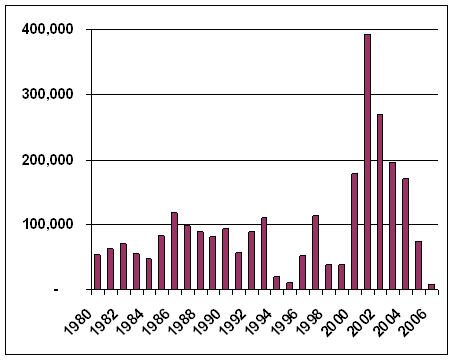Like last year, the Columbia River spring Chinook are missing again. The main difference from 2005, however, is that the fish of ’06 are even more scarce. The fish are rare enough that a weekend Seattle Timesheadline made bold to declare that the run “could be worst ever.” Yikes.
I took a glance at the numbers too see just how bad it is.
First, the good news: the Times headline is probably wrong. It’s likely that we’ll overtake the miniscule return of 1995. But the bad news is that this could easily be the second worst run ever recorded. Here’s a look at spring returns since 1980…
During last year’s late and anemic run, over 31,000 Chinook (more than two-fiths of the total spring run) had already passed the dam by this time. If the 2006 Chinook distribute themselves temporally in the same way that the late run of 2005 did, that would still yield only about 16,500 fish. That’s not good, considering that the long-term average (since 1938) has roughly 100,000 Chinooks returning by the end of May, which is the official end of the spring run.
With just 4 weeks left in the 10 week spring season, there’s much reason to be concerned that something has gone seriously wrong with Columbia salmon stocks.
Some caveats: it’s possible that the run is just very late this year (though even last year’s run was considered aberrationally late). And the logic of reversion to the mean would suggest that low returns so far may actually signal bigger returns in the coming weeks.
Let’s hope so.



